“What is that?!”
I answered the question no less than 15 times while I had my brightly colored jars of kimchi sitting on the counter fermenting.
My answer (“It’s spicy Korean sauerkraut…”) didn’t exactly erase the quizzical look from the faces of the question-askers, but considering most of them are well-acquainted with my weirdness, I doubt anyone lost sleep over it. 😉
I’m generally not willing to be very exotic when it comes to fermented foods. I do enjoy sauerkraut and a good old-fashioned brined pickle, but I have yet to develop a taste for some of the more adventurous ferments, like kvass or even fermented asparagus (I wanted to like it SO BAD, but just couldn’t do it…)
That’s why you haven’t seen kimchi here on the blog before now– not because I didn’t like it, but mostly because I was too afraid to try it. Sorry, just keepin’ in real…
Upon the gentle-prodding of my buddy Matt from Fermentools, I decided to give it a try. He said if we liked sauerkraut (which we do), we’d probably like kimchi. I figured I could handle that.
Wait… What is Kimchi Again?
Kimchi is a traditional Korean dish made with lacto-fermented vegetables (namely cabbage). Lacto-fermentation is the same process we use to make sauerkraut or brined pickles, and is an old-fashioned way to preserve food that imparts probiotic benefits as well.
There are approximately 1.5 billion different ways to make kimchi, and I have no doubt my version would be deemed inappropriate by some… But it’s a good baby-step for us Prairie People who are still slowly expanding our palates, due to the lack of international cuisine options out here.
Some kimchi recipes call for fish sauce, kelp, Asian pears, carrots, radishes, or other veggies. I kept mine simple– partially because it’s hard to source certain ingredients here in Wyoming, and partially because I didn’t feel like being too adventurous… At least not yet.
Therefore, you’ll find pretty basic ingredients in my kimchi recipe: green onions, cabbage, ginger, garlic, and salt. The one “exotic” ingredients you simply MUST have is the Korean red chili powder (gochugaru). Because, nope, you can’t substitute regular red pepper flakes. Thankfully, it was easy to order the Korean chili powder on Amazon, and I’m guessing the bag will last me for the next 5 years worth of kimchi-making…
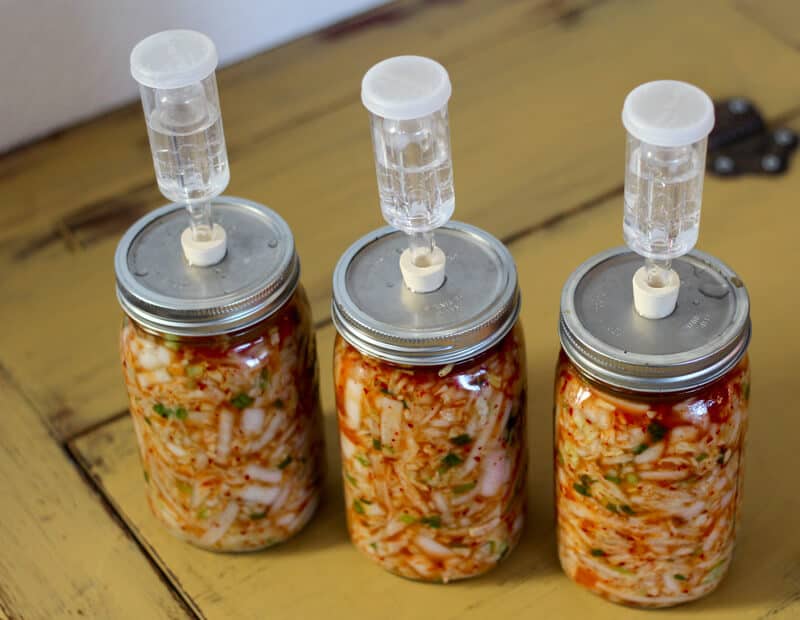
Do I Need Special Fermenting Equipment?
For my first few fermentation adventures, I simply used a regular mason jar and lid. However, I’ve been using air locks from Fermentools for the past few years and haven’t looked back. Are air locks an absolute requirement for making fermented foods at home? Nope. However, they *can* reduce the chance of mold occurring on a ferment, and allow they allow the gasses to escape without you having to “burp” the jar. Basically, if you’re new to fermenting, an airlock makes the whole process pretty much fool-proof. I’ve used my Fermentools non-stop ever since for all sorts of fermenting projects.
Bottom line– you don’t have to use a air lock, but they are pretty handy and often produce a higher quality product in the end. And if you’re making a big batch of anything, half-gallon mason jars are easier to handle (and less expensive) than one of those big ol’ fermenting crocks. (I have one of the 6-packs, which will handle around three gallons of kraut…)

How to Make Kimchi
Yield: Approximately One Quart
- 1 head (approximately 2 lbs) Napa cabbage
- 1/4 cup green onions, coarsley chopped
- 3 large garlic cloves, minced
- 1 teaspoon ginger, minced
- 1 tablespoon gochugaru (Korean chili powder)
- 1 tablespoon salt (I like this one)
(Feel free to double or triple this recipe– it’s just as easy to make a big batch as it is a little one.)
Instructions:
Coarsely chop the cabbage leaves into 1/2 inch (or so) pieces, and place in a large bowl. Sprinkle the salt over the cabbage, mix in well, and allow to sit out at room temperature for 20-30 minutes while you prep the rest of the ingredients.
Once you’ve allowed the salted cabbage to sit, use your hands to mix and mash the cabbage until it starts to shrink and a brine begins to develop in the bottom of the bowl. There isn’t a right or wrong way to do this–the goal is to just start the juices flowing. You’ll want to taste the brine and add more salt, if necessary. The brine should taste quite salty, like sea water.
Mix in the onions, garlic, ginger, and chili powder thoroughly, then start packing the mixture into a clean mason jar. (**I highly recommend wearing kitchen gloves while mixing– as the chili powder has the potential to get under your fingernails, and it’ll hurt….)
I like to add a 1/2 cup of cabbage to the jar, pack down firmly with a wooden spoon, then repeat until I get to the top. Once you get to the top of the jar, the goal is for the cabbage mixture to be completely submerged, with the brine fully covering it by 1″. If you don’t have enough naturally-occuring brine after all your smashing, you can easily make your own 2% brine to top it off (instructions below). I use a glass weight (from my Fermentools kit) to hold down the cabbage, but you can also use a bit of the core. The goal is to not let the kimchi itself be exposed to air.
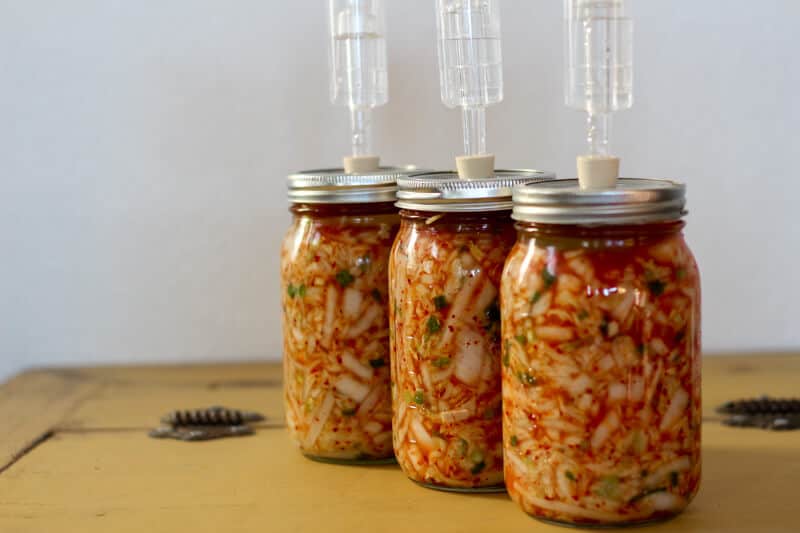
Affix a lid to the jar (fingertight only), and set aside in a room-temperature location, out of direct sunlight, for 5-7 days.
You’ll probably want to place a small dish or tray under the jar, just in case you overfill it a bit and the jars spill over a bit. Also, removing the lid after a day or so to “burp” the jar and release any pent-up gasses is also a smart idea (if you’re NOT using an airlock).
Taste and smell your kimchi after five days. If it’s tangy enough, move to the refrigerator for storage. If you like a bit more tang, simply allow to ferment for a bit longer.
Enjoy your homemade kimchi as a side dish, make kimchi fried rice, kimchi mac n’ cheese, or a host of other kimchi-flavored dishes.
Your kimchi will last a many, many months in the fridge, unless you eat it all before then– that’s one of the beautiful things about fermented foods.
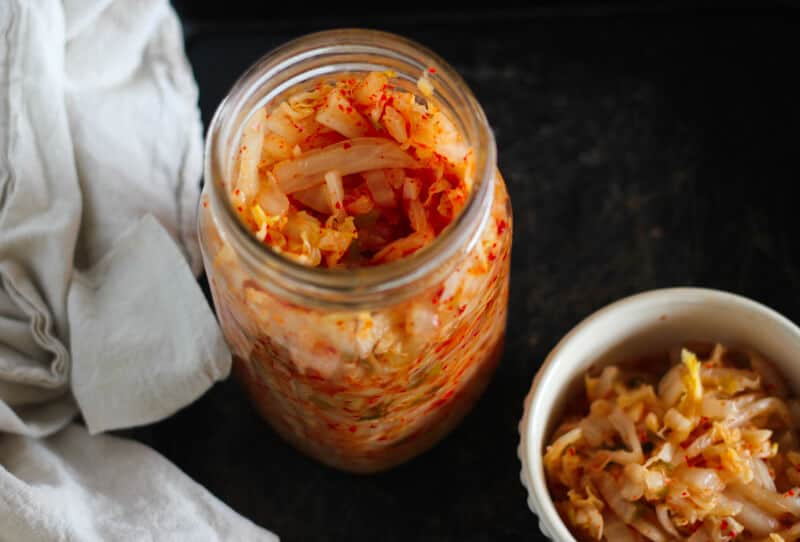
Kimchi Notes
- To Make a 2% Brine: Dissolve 1 tablespoon fine sea salt in 4 cups non-chlorinated water. If you don’t use all of the brine for this recipe, it will keep indefinitely in the fridge.
- Like I mentioned above, there are a million-and-one different ways to make kimchi, so feel free to experiment with the flavors. I’m going to be brave and add fish sauce next time.
- Every time I try a new fermented food, I have to give myself a bit of time to become accustomed to the new flavors. But then within several days, I always mysteriously find myself seeking it out and almost craving it. I suspect that’s my body trying to tell me something.
WHERE TO BUY FERMENTING STUFF?
I’ve been totally impressed with my Fermentools equipment. Here’s why:
- The airlocks work with the jars I already have, so I don’t have to buy special containers or crocks.
- You can easily make big batches of fermented foods with little hassle (no lugging around heavy crocks, either)
- Their glass weights are super nice to just pop into my mason jars so the food doesn’t float out of the brine and get gross.
- There’s a super-handy chart on the front of their ultra-fine powdered salt bags to help you figure out exactly how much you need for the perfect brine
Click here to shop Fermentools
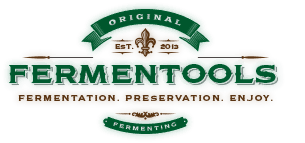
This post is sponsored by Fermentools, which means they sent me one of their air lock systems so I could try it out. However, like everything I promote here on The Prairie Homestead, I don’t promote it unless I’m actually using it and loving it, which is absolutely the case here.

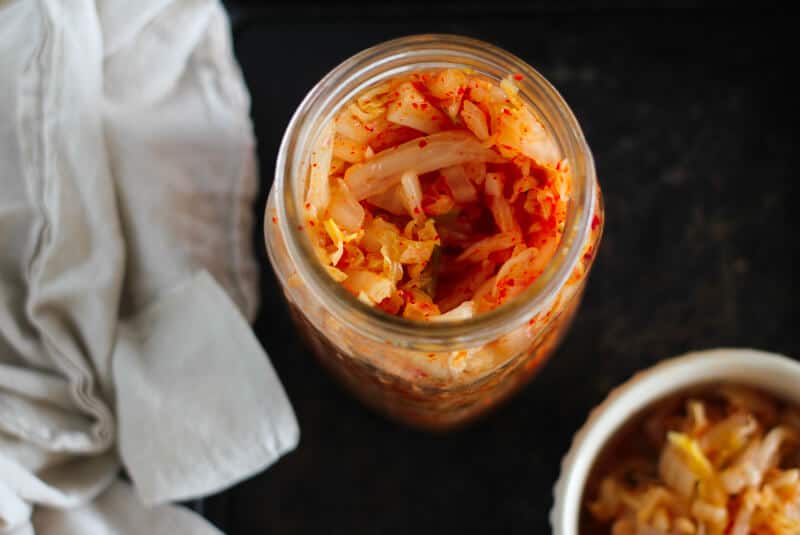
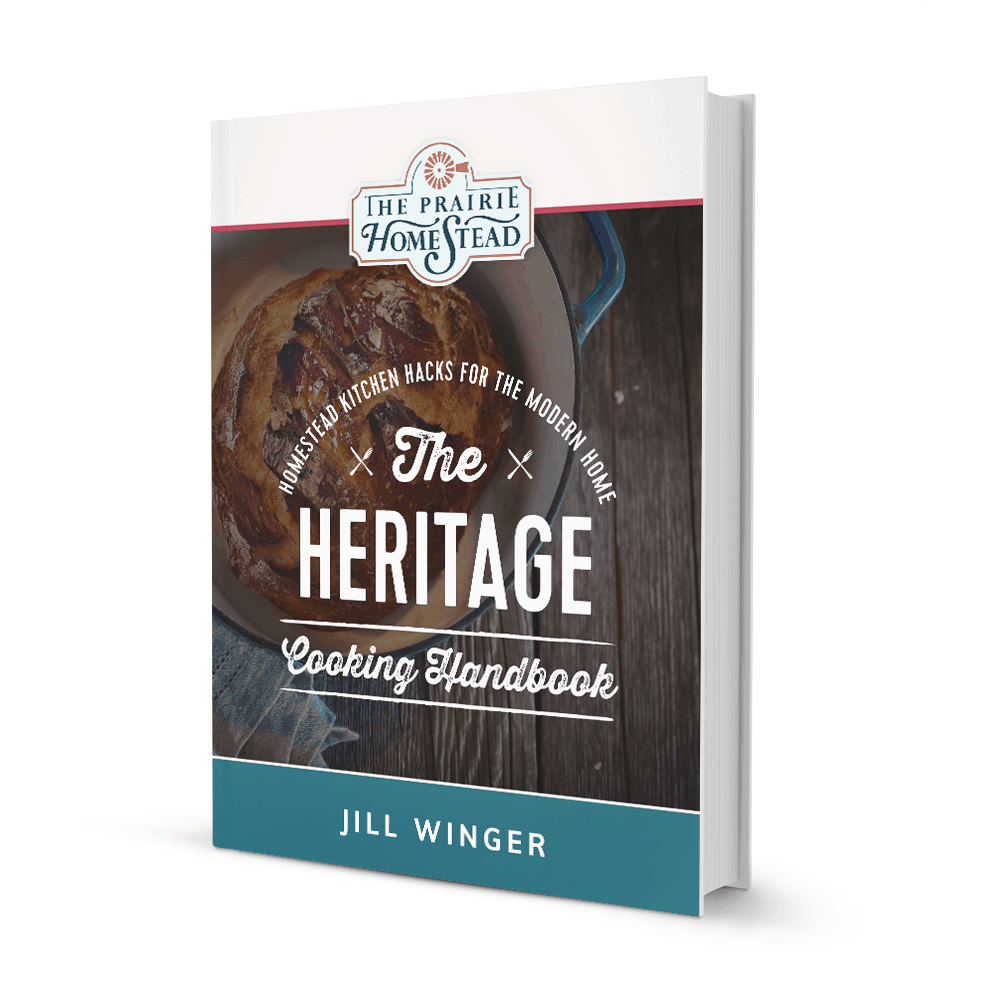

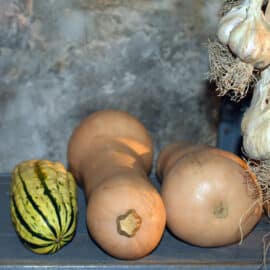
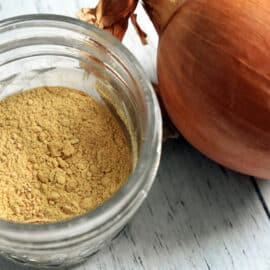

Homemade kimchi is the bomb! Take some cooked leftover pork roast and place in a pan. Add kimchi and enough water to make a nice soup. Heat on low/med till it simmers gently. Makes the best winter soup ever.
That sounds amazing!
What if your (in my case pickles) got mold… just washing in hot water gets the stink out? What’d I do wrong? Too much salt is overbearing!
You need the amount of salt required in the recipe to retard mold growth and break down the the cabbage for the fermentation process. You can always pour off the liquid when the fermentation process is done.
When I lived in Korea I loved cucumber kimchi! Tasted they same but with some crunch ?
I’m going to try that!! It sounds so good! I love kimchi and have it on my eggs every morning.
If your family isn’t as partial to this recipe, there is a cucumber kimchi variety. When I was in Korea, most Americans greatly preferred the cucumber kimchi to the traditional cabbage. I’ve never tried making it myself though, might have to give it a go.
I haven’t heard of that– sounds like an interesting option tho!
Cucumber is a very common variety. Try radish (Asian radish) as well. Radish is crunchier than other types.
Cucumber kimchi is great!
Knew someone who did not like cabbage, he made his own kimchi using cucumber instead.
I won a mason jar fermentation kit at the Vermont Fermentation Festival, last Fall. Made Kvaas and then a neighbor asked if I would try making Kimchi with just cucumbers. Played around with a few recipes and it was a success. The kit from MasonJar Lifestyle came with special lid, Airlock and glass weight. I had also read about “followers” to keep food down and liquid up. So I made several from food safe teflon sheets, that I perforated. I place them under the glass weight and they work like a charm! Might be over kill, but that’s how I get when trying something new.
I saw the pictures with the fermenting kit and instantly was about to comment ‘Do I need to have the special fermenting stuff?’ and then you answered my question for me right below! Beautiful! How often do you find that you get moldy ferments if you arn’t using the tools on top of the jar? Thanks!
I put away napa cabbage in the fridge loosely wrapped because it lasts forever for fresh salad in the winter. A Korean friend has come over to make kimchi with me and I recommend not to ever shred it, to use fish sauce sparingly, and I like the daikon radish flavor very well since it is mild. These grow right past frost, and are used by Amish gardeners nearby as winter covercrop to till under in the spring. Kimchi ramen noodles are good, but I usually use a few tablespoons when the enzymes make my stomach feel good, not all the time.
Thank you very much for this great information. Is the kimchi you made very spicy?
You can buy different levels of spiciness in your red pepper powder. That’s how you control the spiciness.
How ironic that this is your post on the day I am making kimchi for the first time ever! Just got the rest of my ingredients on today. My favorite kimchi I ever had was 5 year old kimchi. For lots of ways to use your kimchi, a great place to go is http://www.maangchi.com
Thanks for sharing that link!!!
I wish you hadn’t posted this. Now I’ll have to make it.
I was introduced to kimchi by my first supervisor out of college at a local Chinese restaurant (Chinese, not Korean). I loved it. Later, I tried saurkraut, and I love it, too. I’ll even eat it cold because kimchi is served cold (that freaks out some people).
For several years after I moved to Davis California I did accent reduction training and editing for visiting Korean doctorals and post-doctorals. I learned a LOT from those folks!! All of them who were here with family had a variety of Kimchi, and being a “teacher” I got gifted or served some every so often. I always ate it politely, but never really enjoyed it. Your post convinces me I should experiment. I have good luck with sauerkraut. I use small crocks, which come from thrift stores and are all different,and put water-filled ziplock bags on top to keep the veggies submerged and to permit gas release about their edges. Super cheap arrangement. Many years ago, I used to ferment quite a bit of beer, and used airlocks that appear identical to your fermentools in the necks of five gallon glass carboys. They were very handy.Love your blog!!
we make sauerkraut and place ziplock bags of water on top of cabbage with a plate underneath to keep the cabbage submerged.would that work with kimchi as well.we do the kraut 6 weeks haw long for kimchi??
I have a Korean friend that taught me how to make Kimchi. She makes cabbage and cucumber but my favorite is cucumber. She also adds, carrots, onions, sesame oil, salt and vinegar. My family loves it.
I love love love Kimchi! I’ve been making it for a few years now. I use my pickling crock and it works great! I basically use the same ingredients as the recipe except I add some daikon radish into the mix. I love it straight out of the jar and in my ramen noodles. So very good for your tummy!
Have you ever tried the silicone airlock waterless fermentation lids?
If so, how did they compare to the airlock system you show in your post
What are you putting in your airlock? Do you add a sanitizer like you would with brewing beer?
Thanks!
Do you use fine ground or course ground gochugaru?
I find it quite easy to substitute cayenne or pasilla pepper (dried and ground) for gochugaru pepper. I’ve been making Kim Chi for decades, and agree…about 150,000 ways to do it! There are English cookbooks with hundreds of variations.
Hey! If you can get hold of miso paste in your local store, I would 100% recommend adding a few tablespoons to your gochugaru paste/rub. It keeps it safe for those with seafood allergies or dietary restrictions for meat. Also, fish sauce is a good way to get it to get a good authentic kimchi funk on and is pretty common even in very backcountry places-you’ll usually find it with the teriyaki sauce 😉 you might also be able to find miso paste around the produce or in a freeze locker.
You mention air locks and valves. Could you expound on how to use those features for Kim chi, please?
You can find more information on fermenting air locks in this article: https://www.theprairiehomestead.com/2015/02/how-to-make-sauerkraut.html